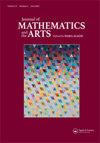Visualizing mathematics with quilts
IF 0.2
Q4 MATHEMATICS, INTERDISCIPLINARY APPLICATIONS
引用次数: 0
Abstract
I grew up with sewing machines and power tools. The basement of my family home in Michigan was full of all kinds of drills, saws, and a sewing machine. My mother and father taught me how to use these machines. I remember always doing things with my hands and wanting to be a visual artist. When it came time to attend a university, my practical-minded mother insisted that I study ‘something that would enable me to support myself’. I laugh, as I recall my youth. I took my mother’s advice and eventually earned a B.A. in Mathematics, an M.A. in Mathematics Education, and an Ed.S. in Educational Administration. Teaching at West Lafayette High School in West Lafayette, Indiana, along with a mathematical methods class to future teachers at Purdue University, I found a strong desire to include mathematically inspired art in my classrooms. At this point, I had been investigating various media including drawing, photography, bronze, painting, and stained glass. In 1980 I discovered a book that changed my life: Geometry and the Visual Arts, by British mathematician Daniel Pedoe. Each page of Daniel’s book spoke to me. I knew I was on to something as I completedmy reading. Themedium of fabric was interesting as it could combinemathematical ideas, colour, texture, shape, perspective, and is totally hands-on. Fabric would allowme to include mathematical ideas for teaching plus give me the ability to hang the mathematical quilts in my classroom. I began generatingmathematical quilts specifically for the classroom. I co-authoredwith Dr. Diana Venters, two books on using quilts as the springboard for explaining mathematical theorems and formulas in the classroom. As students investigated the mathematics in each quilt, lesson plans evolved that could be included in a book on mathematical quilts. Mathematical Quilts andMore Mathematical Quilts resulted. I continue to learn more mathematics and generate more mathematical quilts even though I am retired. To date, I have generated 67 mathematical quilts. The quilts encompass roughly 4,000 years of recordedmathematics. Beginning in 2,000 B.C.E. to the present, 67 quilts represent most of the significant time periods for mathematics. All of my quilts are needle-turned versus using a fused raw edge technique. Ninety percent of my quilts are hand-quilted and are made of 100% cotton. The London Science Museum owns 6 of my quilts in their permanent collection.用被子形象化数学
我在缝纫机和电动工具的陪伴下长大。我家在密歇根州的地下室里堆满了各种各样的钻头、锯子和一台缝纫机。我的父母教我如何使用这些机器。我记得我总是用手做事情,想成为一名视觉艺术家。到了上大学的时候,我那务实的母亲坚持要我学“能养活自己的东西”。我笑,当我回忆我的青春。我听从了母亲的建议,最终获得了数学学士学位、数学教育硕士学位和教育学硕士学位。在教育管理。我在印第安纳州西拉斐特的西拉斐特高中(West Lafayette High School)教书,同时在普渡大学(Purdue University)为未来的教师开设数学方法课程,我发现自己有一种强烈的愿望,希望在课堂上加入受数学启发的艺术。在这一点上,我一直在研究各种媒体,包括绘画,摄影,青铜,绘画和彩色玻璃。1980年,我发现了一本改变了我一生的书:英国数学家丹尼尔·佩多的《几何与视觉艺术》。丹尼尔书中的每一页都在跟我说话。当我完成阅读时,我知道我发现了一些东西。织物的媒介很有趣,因为它可以结合数学思想、颜色、纹理、形状、视角,而且完全是动手的。织物可以让我在教学中融入数学思想,还可以让我在教室里挂数学被子。我开始专门为教室制作数学被子。我和Diana Venters博士合著了两本书,是关于在课堂上用被子作为跳板来解释数学定理和公式的。当学生们研究每一床被子里的数学知识时,课程计划也随之发展,这些计划可以被纳入一本关于数学被子的书中。数学被子和更多的数学被子。虽然我已经退休了,但我仍然继续学习更多的数学,制作更多的数学被子。到目前为止,我已经制作了67个数学被子。这些被子包含了大约4000年的有记录的数学。从公元前2000年到现在,67条被子代表了数学最重要的时期。我所有的被子都是用针翻的,而不是用融合的毛边技术。我的被子90%都是手工绗缝的,100%是棉的。伦敦科学博物馆永久收藏了我的6条被子。
本文章由计算机程序翻译,如有差异,请以英文原文为准。
求助全文
约1分钟内获得全文
求助全文
来源期刊

Journal of Mathematics and the Arts
MATHEMATICS, INTERDISCIPLINARY APPLICATIONS-
CiteScore
0.50
自引率
0.00%
发文量
19
 求助内容:
求助内容: 应助结果提醒方式:
应助结果提醒方式:


